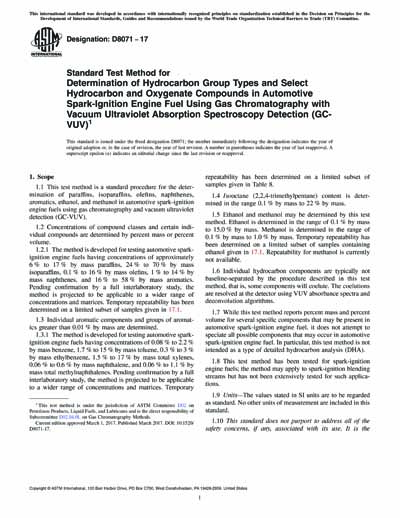Historical
ASTM D8071-17
Standard Test Method for Determination of Hydrocarbon Group Types and Select Hydrocarbon and Oxygenate Compounds in Automotive Spark-Ignition Engine Fuel Using Gas Chromatography with Vacuum Ultraviolet Absorption Spectroscopy Detection (GC-VUV)
1.1 This test method is a standard procedure for the determination of paraffins, isoparaffins, olefins, naphthenes, aromatics, ethanol, and methanol in automotive spark-ignition engine fuels using gas chromatography and vacuum ultraviolet detection (GC-VUV).
1.2 Concentrations of compound classes and certain individual compounds are determined by percent mass or percent volume.
1.2.1 The method is developed for testing automotive spark-ignition engine fuels having concentrations of approximately 6 % to 17 % by mass paraffins, 24 % to 70 % by mass isoparaffins, 0.1 % to 16 % by mass olefins, 1 % to 14 % by mass naphthenes, and 16 % to 58 % by mass aromatics. Pending confirmation by a full interlaboratory study, the method is projected to be applicable to a wider range of concentrations and matrices. Temporary repeatability has been determined on a limited subset of samples given in 17.1.
1.3 Individual aromatic components and groups of aromatics greater than 0.01 % by mass are determined.
1.4 Isooctane (2,2,4-trimethylpentane) content is determined in the range 0.1 % by mass to 22 % by mass.
1.5 Ethanol and methanol may be determined by this test method. Ethanol is determined in the range of 0.1 % by mass to 15.0 % by mass. Methanol is determined in the range of 0.1 % by mass to 1.0 % by mass. Temporary repeatability has been determined on a limited subset of samples containing ethanol given in 17.1. Repeatability for methanol is currently not available.
1.6 Individual hydrocarbon components are typically not baseline-separated by the procedure described in this test method, that is, some components will coelute. The coelutions are resolved at the detector using VUV absorbance spectra and deconvolution algorithms.
1.7 While this test method reports percent mass and percent volume for several specific components that may be present in automotive spark-ignition engine fuel, it does not attempt to speciate all possible components that may occur in automotive spark-ignition engine fuel. In particular, this test method is not intended as a type of detailed hydrocarbon analysis (DHA).
1.8 This test method has been tested for spark-ignition engine fuels; the method may apply to spark-ignition blending streams but has not been extensively tested for such applications.
1.9 Units—The values stated in SI units are to be regarded as standard. No other units of measurement are included in this standard.
1.10 This standard does not purport to address all of the safety concerns, if any, associated with its use. It is the responsibility of the user of this standard to establish appropriate safety and health practices and determine the applicability of regulatory limitations prior to use.
Content Provider
ASTM International [astm]






